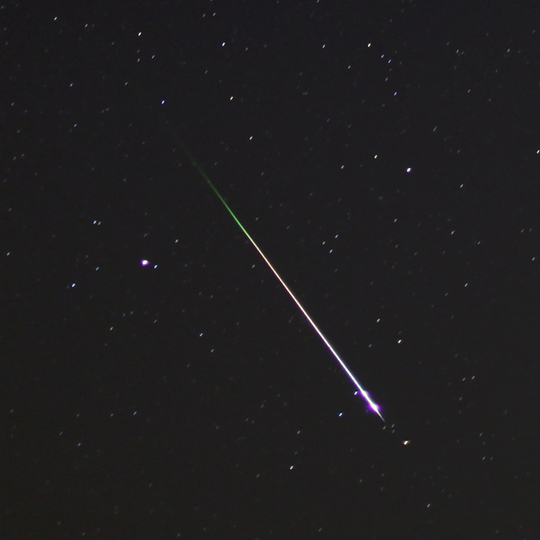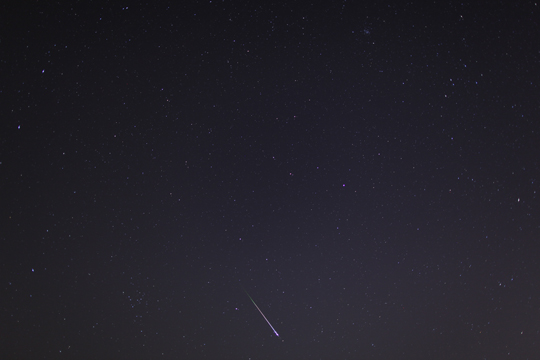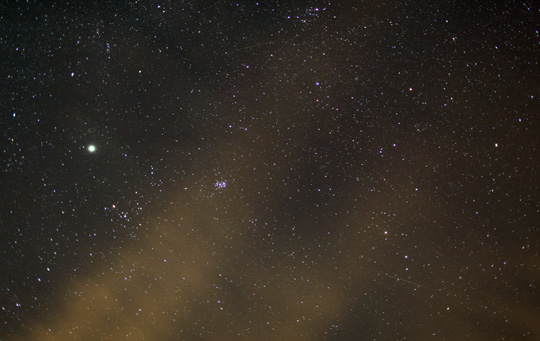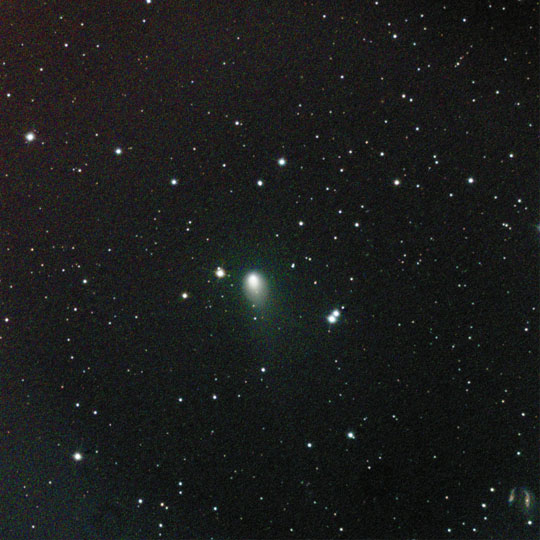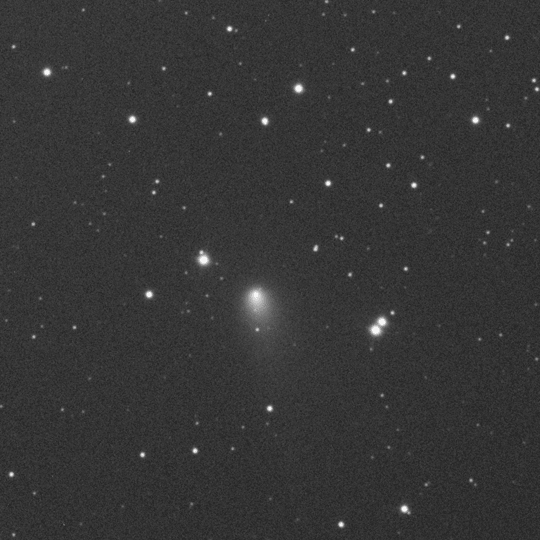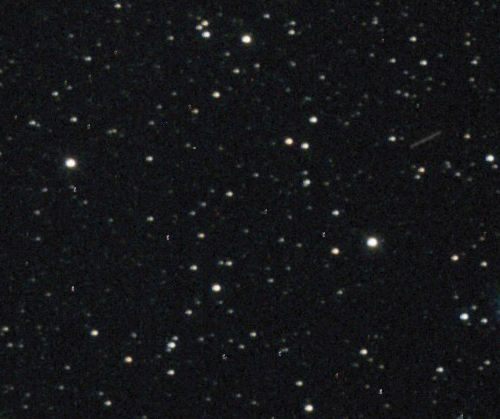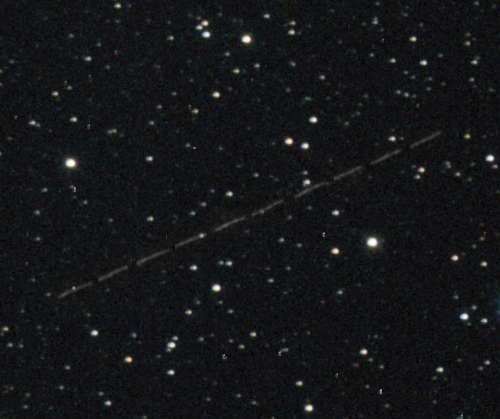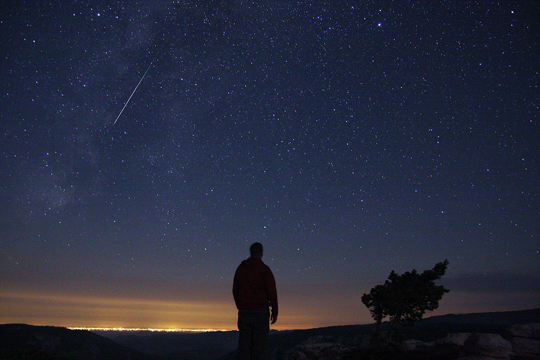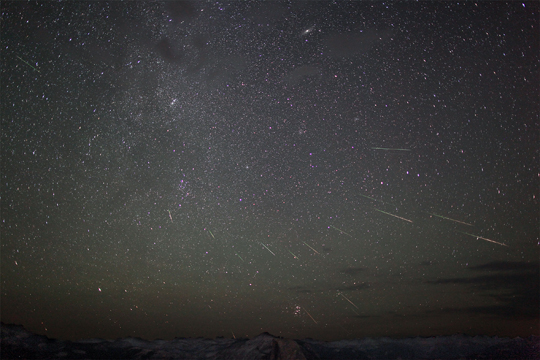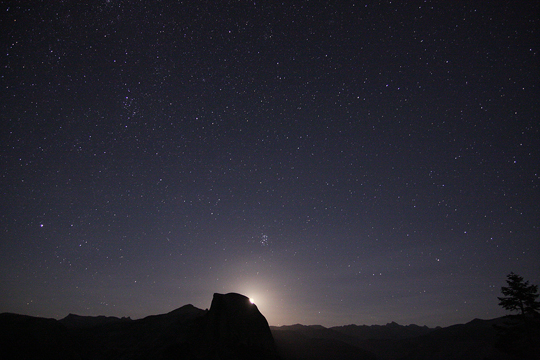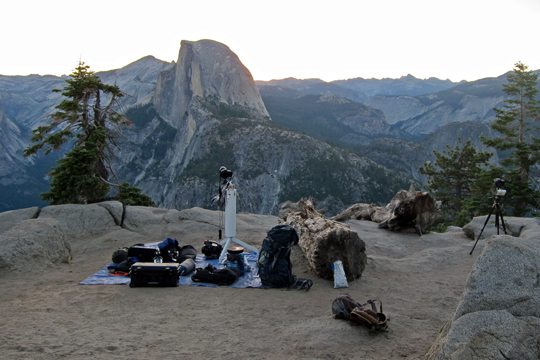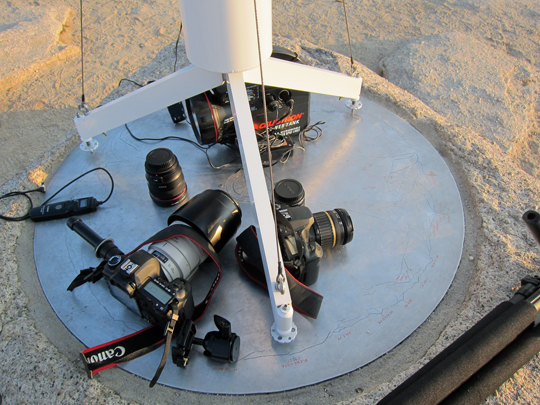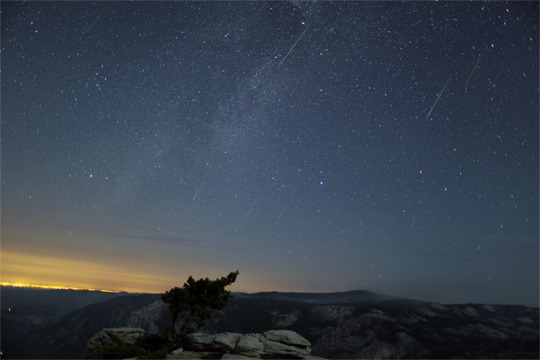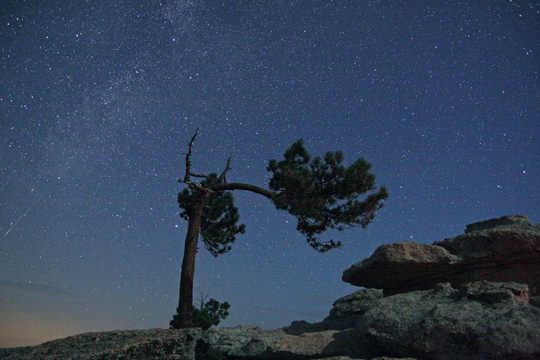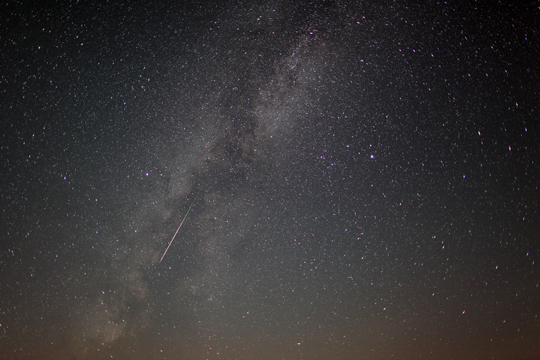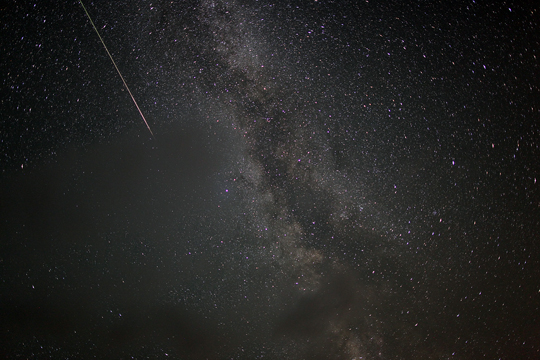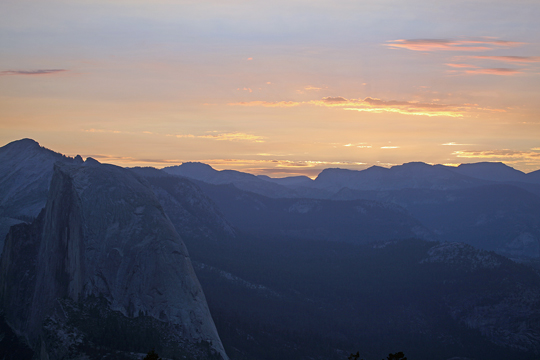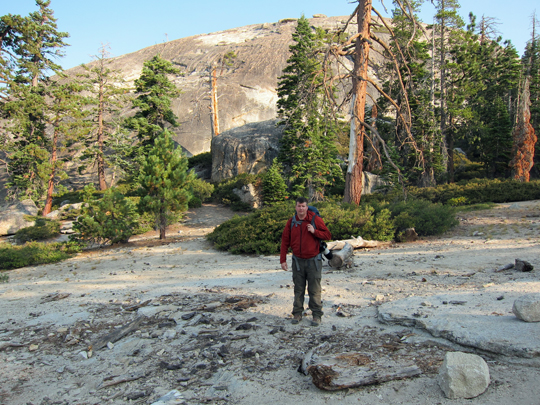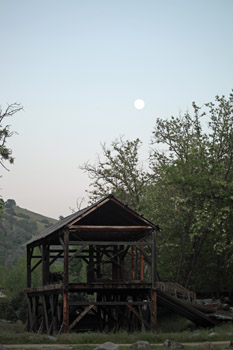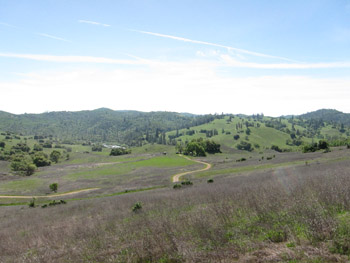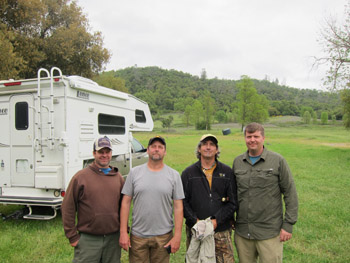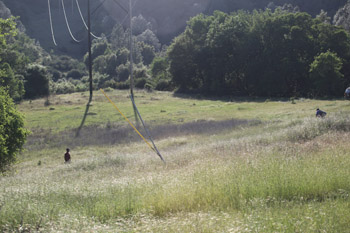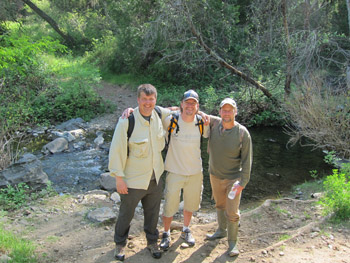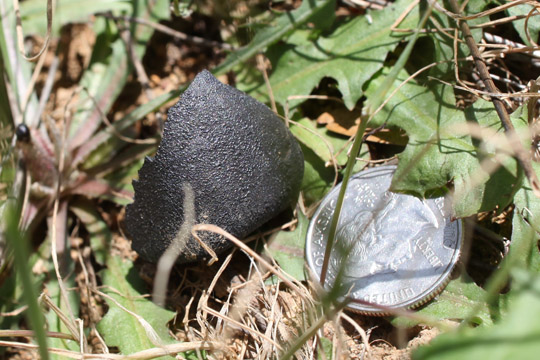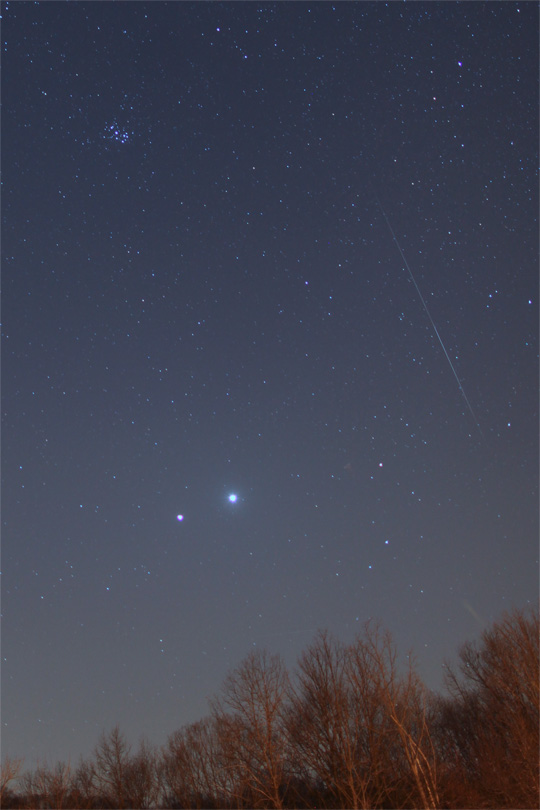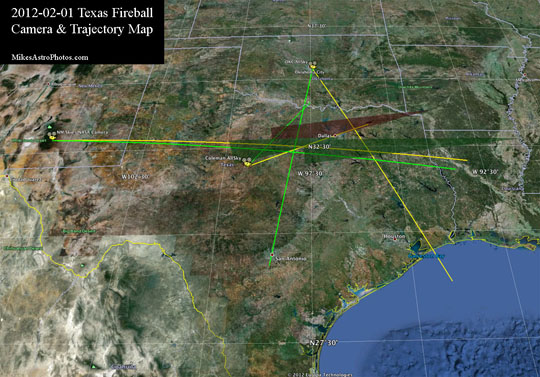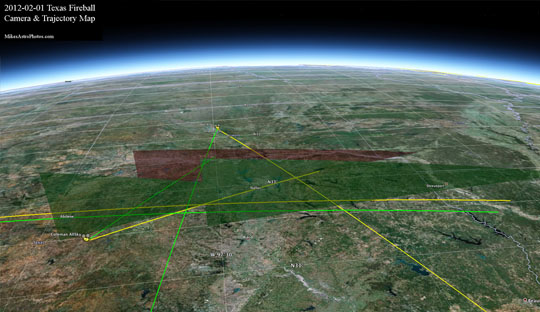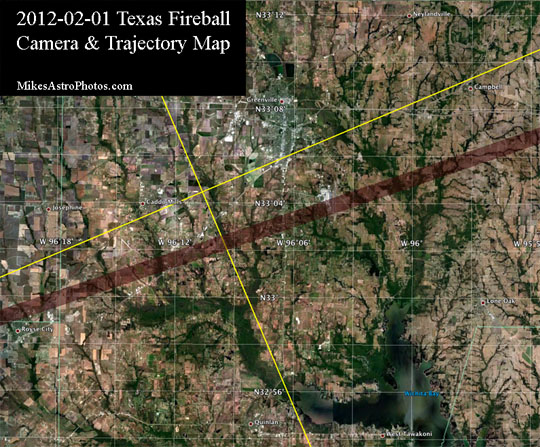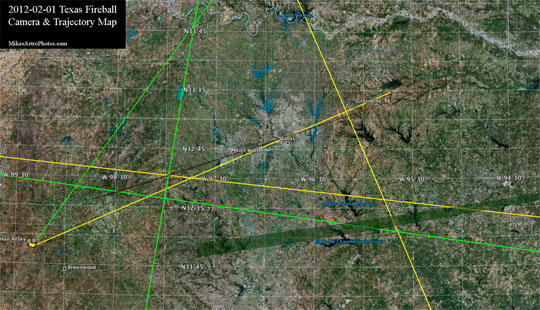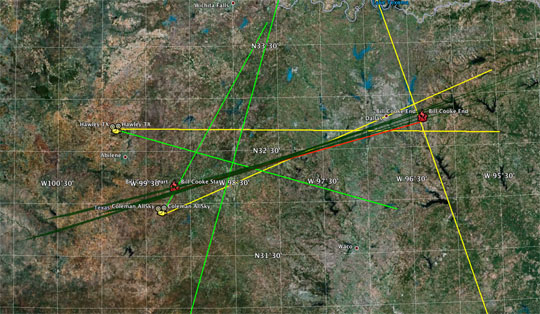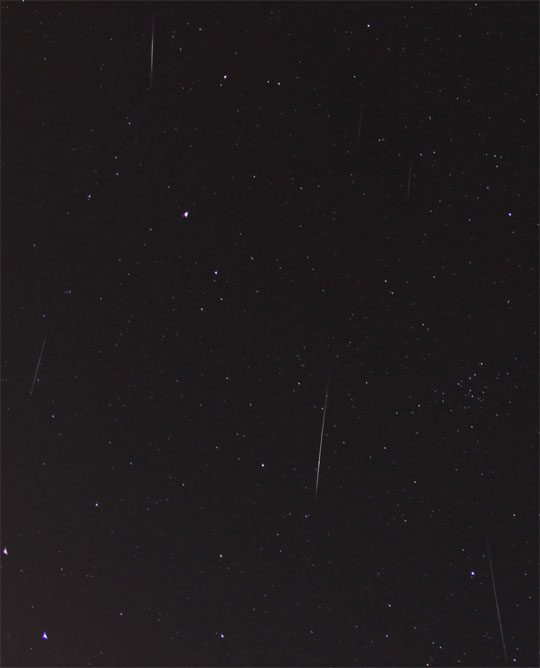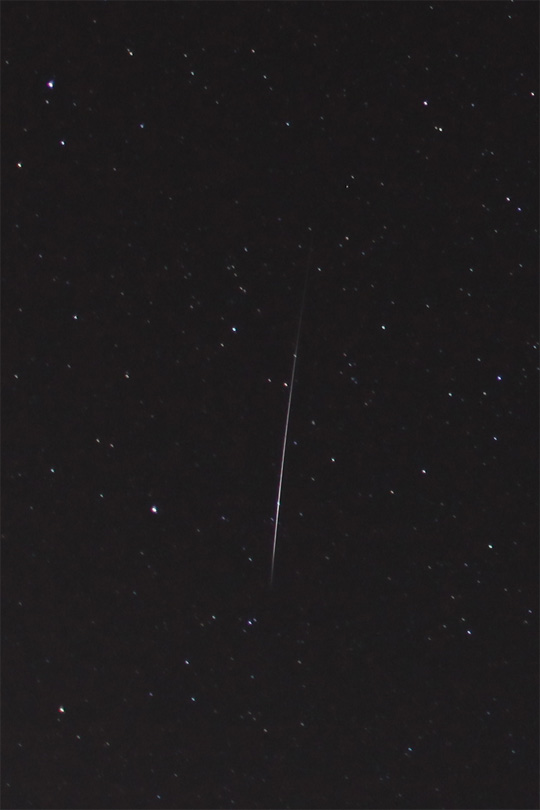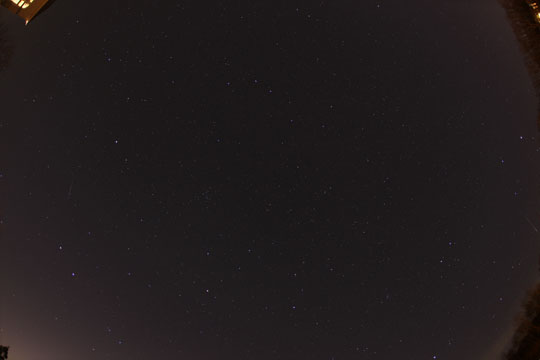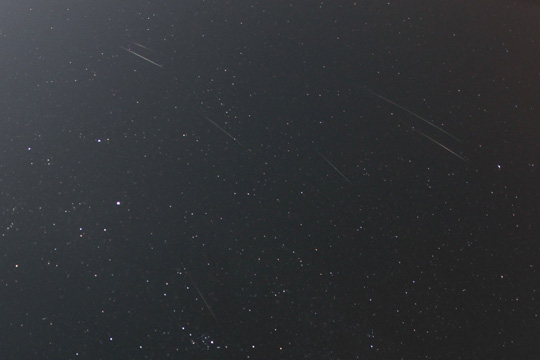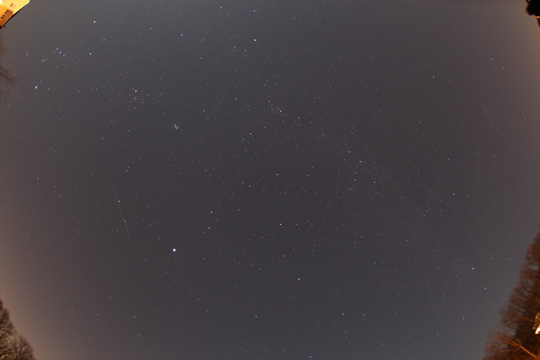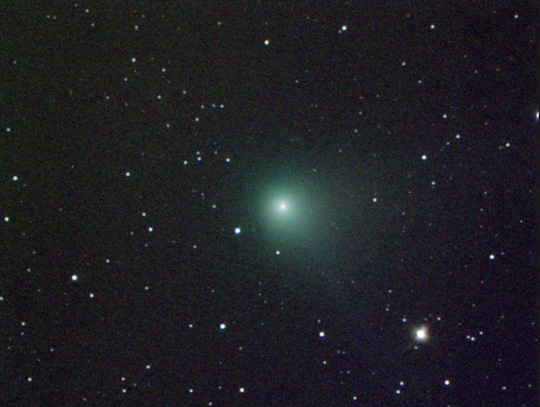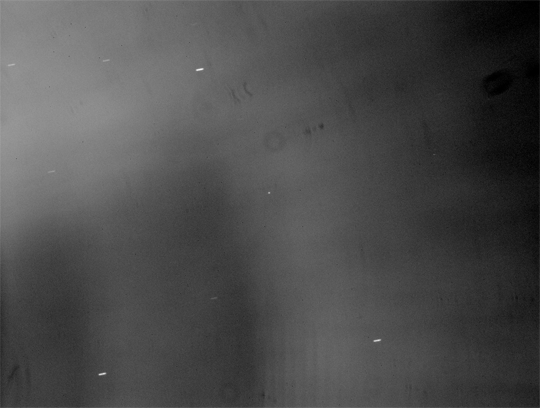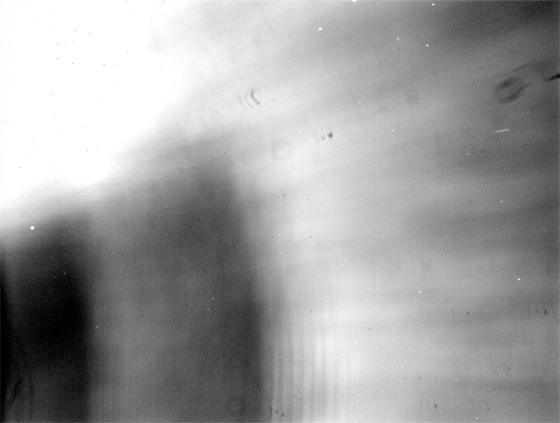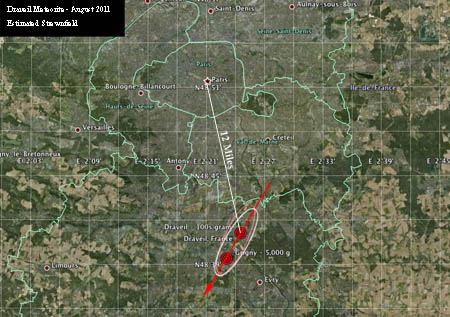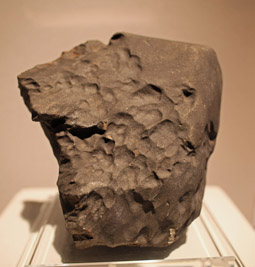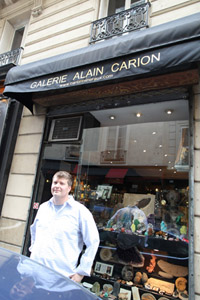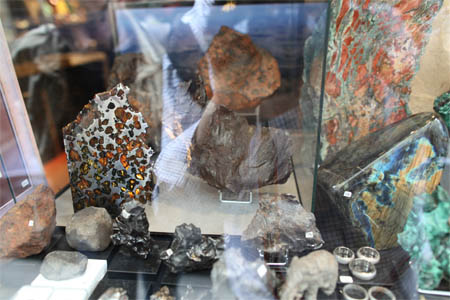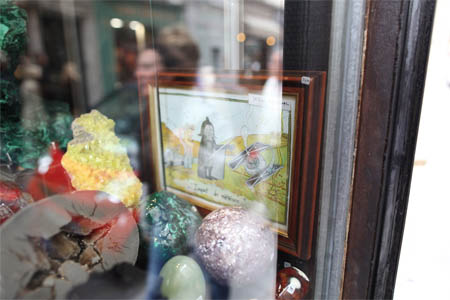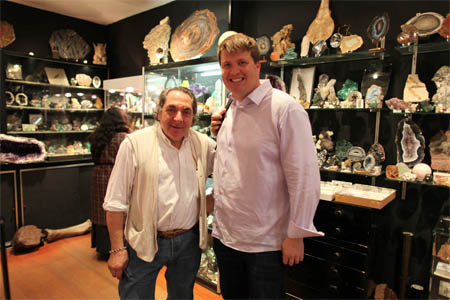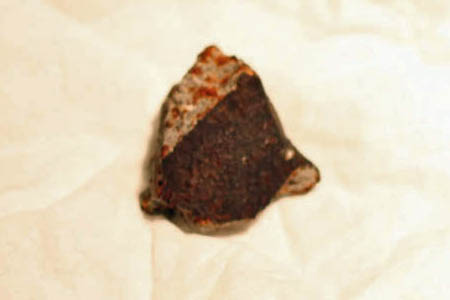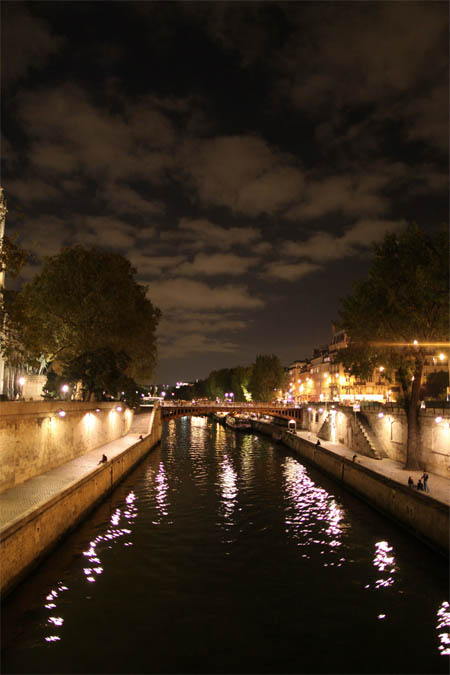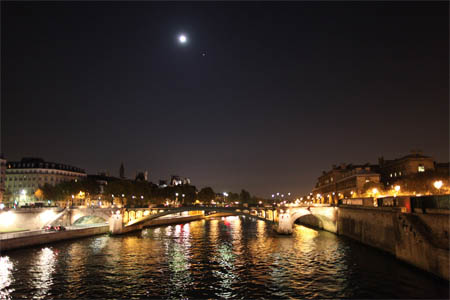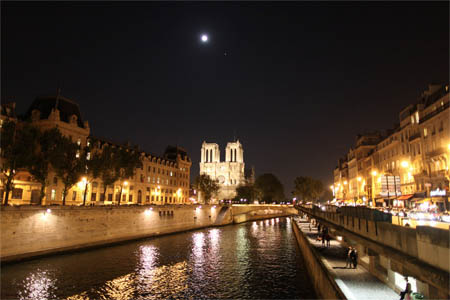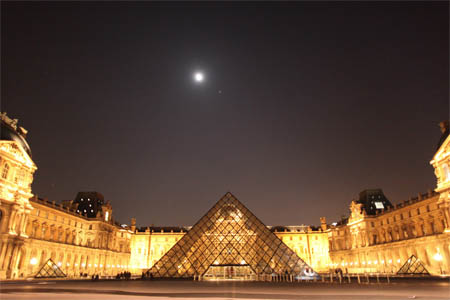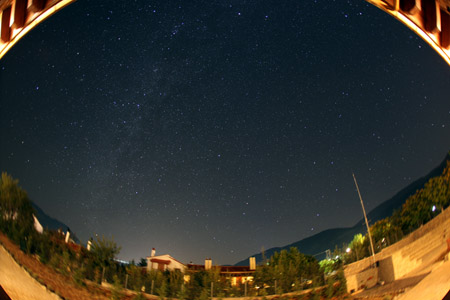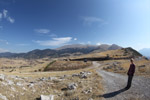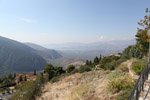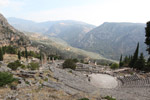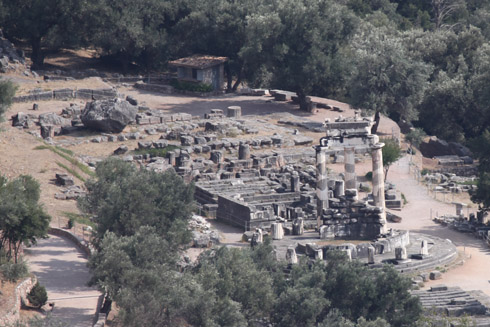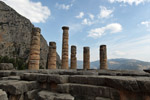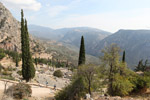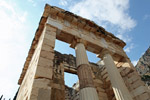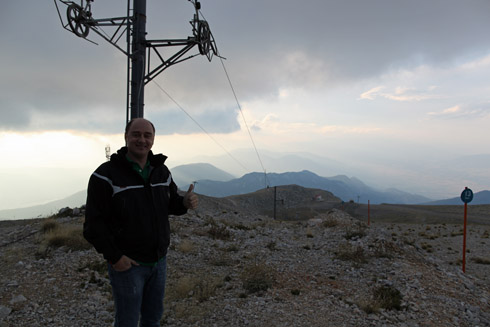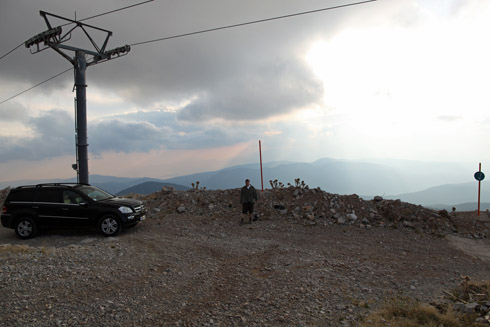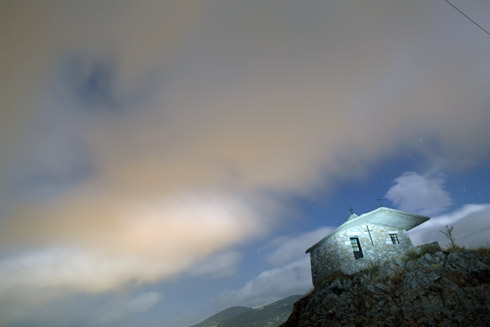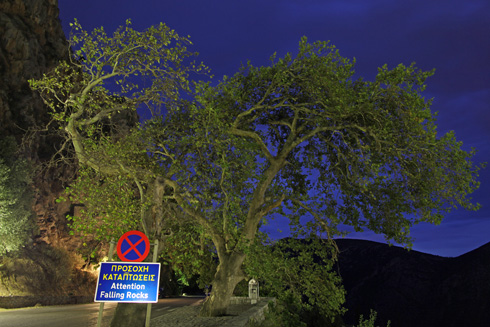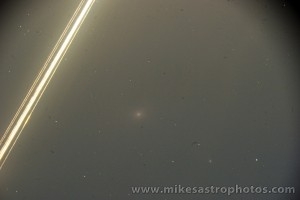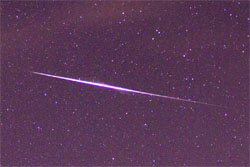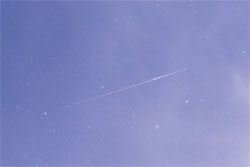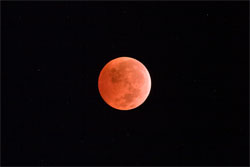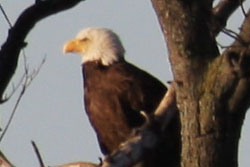Comets & Meteors
Leonid Meteor Corrected: November Iota Draconids Meteor
by Mike Hankey, under Comets & Meteors
Update Dec 5, 2012 — After examining this meteor photo Bob Lunsford author of Meteors and How to Observer Them let me know that this is not actually a Leonid meteor, but rather a November Iota Draconids Meteor. Despite the fact that it occurred during the leonid meteor shower peak and actually appears inside the Constellation Leo, the meteor does not align with the Leo radiant, rather this meteor originates from the Draconid radiant.
I’ve been burning the candle at both ends, between astronomy and meteorite hunting not to mention my real job and home life. My wife went away for the weekend to visit with her family and I’ve been pulling Mr. Mom duty. Yes its tiring, but last night was the peak of the Leonids, the moon set early and there were no clouds. So I setup a camera on my balcony and went to bed early, but shot all night long. While reviewing the pics this morning, I was a little disappointed by the lack of meteors I had captured, that is until I came across this guy. I only caught 2 meteors the whole night, but it was worth it for this bright Leonid.
The picture above is a full resolution crop of just the meteor. Here is the full frame reduced in size.
Photo Details
Image taken with Canon 5d Mark II Camera and Canon 35mm f1.4 L USM EF Lens. Tripod mounted (no tracking) 25 second exposure @ ISO 400.
A Couple Of Orionids 2012
by Mike Hankey, under Comets & Meteors
The Orionid Meteor Shower peaks this Saturday evening and Sunday morning! It was clear last night and I got some warm up practice time in. There wasn’t a lot of activity, but I did catch a pair of Orionid Meteors.
Comet 168P/Hergenrother
by Mike Hankey, under Comets & Meteors
Here’s a quick photo of Comet 168P/Hergenrother. This comet just reached its perihelion (closest point in orbit) on 1 October 2012. The photo below was created with a 1 minute exposure of RGB and 2 minutes of Luminance. There’s a good bit of noise in this image, but I figured out a bunch of tricks for taking and processing comet images while I was shooting this series. It was a productive session and my next round of comet photos should be much better. There’s a few tricks to photographing comets well (just like everything) and I look forward to shooting this guy again before he travels too far away. Check out the pair of faint distant galaxies in the lower right corner.
And here’s an animation of 10 frames of the comet. Each exposure is 30 seconds and there is an aproximate 300 second break in between each frame.
Photo Details
Comet 168P/Hergenrother
RGB 60 seconds 120 seconds Lum
Total exposure 2 hours 30 minutes
Camera: Apogee U16M
Guider: SBIG 402 with MMOAG Off Axis Guider
Telescope: RCOS 14.5
Mount: Paramount ME
Location: Freeland MD
Date: 10/6/2012
Software: The SkyX, MaximDL, FocusMax, CCDAutoPilot, CCDStack, Photoshop
Potentially Hazardous Asteroid – 2012 QG42
by Mike Hankey, under Comets & Meteors
Near Earth Asteroid, 2012 QG42 was discovered on August 26th and will be passing Earth tonight, Thursday September 13th, 2012. Moving at 7 miles per second this asteroid is estimated to be 625 to 1,400 feet long. I was able to acquire the target last night and take a few pictures. Here’s an animation of 10 frames of the asteroid. Each frame is a 60 second exposure.
Here is a composite image of the asteroid over the 10 minute period I was photographing it.
Perseid Meteor Shower – Yosemite National Park 2012
by Mike Hankey, under Comets & Meteors
I flew out to Fresno California to observe the Perseid meteor shower peak with Brendan Fallon my old friend, college roommate and meteorite hunting companion. We made it to the Yosemite National Park by early afternoon Friday, checked out the valley and scoped out possible locations for observing and photographing the meteor shower. Later in the day, we worked our way up to glacier point to observe the shower the night before the peak.
Glacier point is known as an astronomers hangout and many of the rangers recommended it to us as the place to be. I was surprised by how many people where there to watch the shower Everyone was talking about the shower and really excited about it . The San Jose Astronomical Society was hosting a star party on the ridge and over 100 people where there to see the show. We found a little area outside the fences on the edge of Glacier Point and setup our equipment with intentions of staying there all night. Camping is not allowed at attractions like Glacier Point but staying there all night, so long as you’re not sleeping or pitching a tent is totally fine. We were all setup a little before sunset and shot the skies with two cameras the entire night.
I spent most of the night fiddling with the cameras and had less time to relax and observe the shower, but Brendan was able to kick back and counted over 100 meteors the first night. I was not keeping a good count, being distracted by technical devices, but registered about 50-60 meteors. We both stayed up the entire night, and as celestial fortune would have it, on this night and only this night the moon, the Pleiades, Jupiter, Venus and the Sun would all rise over half dome. We were in the perfect location to watch all of this along with thousands of shooting stars all over the place. It was amazing.
After the sun rose around 7:00 AM we packed up our gear and slept for the rest of the day at a hotel an hour away from the park.
On Saturday, we made our way back to Yosemite by 7:00 PM and headed straight for Sentinel Dome. The top of the dome is about an hour hike from the parking lot and we each had packs filled with camera equipment and camping gear. At the peak of the dome in the center of the space, there was a big rock with a leveled metal compass in the middle. It was the perfect perch for my portable astrotech pier and tracking mount.
I was so amped to be on top of Sentinel Dome at 8,100 feet above sea level with 360 degree views of the entire park. It was amazing! After spending a night on Sentinel Dome I am convinced this is the BEST place on the planet to observe a meteor shower.
Every landscape view was breath taking, the skies were as dark as I’ve ever seen and there were meteors everywhere every minute. What else could you ask for?
I was much better about my counting this night and we played a counting game together, competing to see who would observe more meteors. Each time one of us saw a meteor we needed to say our count out-loud followed by the other persons count. It was a competition the entire night and helped keep us awake, alert and engaged in the shower. For the night of the peak I was able to count 250 meteors and Brendan counted 246.
Sentinel Dome is harder to get to than Glacier Point and we thought we would have the whole place to ourselves, especially since no-one was there after sun-set, but believe it or not throughout the night, several parties arrived at the dome after dark. Some getting there as late as two or three in the morning. I was again impressed with how many people who were interested in the shower and dedicated enough to make it out. We all shared a common bond watching the shower together from one of the highest points in Yosemite park.
That morning we watched the sun rise again and then hiked back to our car.
We were both exhausted and sleep deprived but still wide awake and pumped up from the adrenaline of the park, the meteors and the observing experience.
To date, this is the very best meteor observing experience I have ever had and I am convinced Yosemite and specifically Sentinel Dome is the best meteor observing location in the world for viewing the Perseid Meteor Shower.
Sutters Mill Meteorite Hunt – Coloma CA
by Mike Hankey, under Comets & Meteors
On April 22nd, 2012 a large daytime fireball raced across the California and Nevada skies at the early morning hour of 7:50 PST. Thousands of eye witnesses saw the fireball and about 100 reported it to the American Meteor Society. Two lucky folks captured the meteor on film. Lisa Warren from Reno Nevada was walking her dog, had her camera with her and was able to photograph the fireball as it came down. A few weeks later, a video of the fireball surfaced that was serendipitously captured by a film-maker that morning.
Using just the termination azimuth from Lisa Warren’s photo, meteor-radar experts Marc Fries and Rob Matson scanned the doppler radar looking for something odd. They found it, just over Coloma CA, a large abnormal doppler radar return over 8 miles long and 2 miles wide. This was in fact a cloud of meteorites falling to the ground.
Within less than 48 hours of the fall, meteorite hunter Robert Ward was under the radar return and found the first fragment at the Lotus Henningsen park in Lotus CA. As the hours and days went on, dozens of more fragments were recovered from the park and surrounding areas.
A meteorite fall like this happens in the USA only once every 1-2 years and this one in particular is very special because this specific type of meteorite is extremely rare. In fact, it is possible this is a new type that has never been classified. The rarity of this stone not only puts a high scientific value on the fall, but also a high financial value. While I’m not in it for the money, I could not pass up an opportunity to find a meteorite and right now there is no better place on the planet to find a fresh meteorite than Coloma CA.
I flew out with a friend on April 29th, exactly one week after the fall and stayed in a great cabin in Coloma along the American River right in the middle of the strewnfield. Before leaving I analyzed the witness reports and picture and determined a trajectory path that cut just south of the radar returns on a heading of 280º WNW. I studied the land and found Cronan National Park on the upper end of the strewnfield — this would be a perfect location to search and I knew stones had to be there. We searched this park the first day and the last day we were there.
By the second day I had connected with my meteorite hunting friend Larry Atkins and he invited me to join his group of meteorite hunters, which included Scott Johnson and Keith and Dana Jenkerson of KDMeteorites.com. We had a lot of fun hunting together and Dana had communicated with most of the landowners in the area and gotten permission to hunt 1000s of acres of private property. Getting search permission is one of the more time consuming and tedious aspects of meteorite hunting and it was great to have a pro taking care of this for us. The group agreed targeting properties adjacent to areas where meteorites were already found was the best strategy. This made perfect sense to me and finds were being reported all around us, but try as we might we couldn’t make a find the entire week and most of the other guys had been there for 5 days before me.
One of the problems with this fall, is the fragments are very spread out. Only one meteorite is being found for every fifty acres searched. Dozens, possibly hundreds of meteorite hunters were scouring the entire area and making very few finds. The first three weeks most of the finds were coming from locals who have found the meteorites on their driveways and yards and meteorite hunters are having a very difficult time as brute force gridding and zombie hunting are simply not working. The hunting is very difficult because most of the ground is either 4 foot tall grass or woods. There is lots of poison oak and also briar patches, rattle snakes and mountain lions, oh my.
On a typical day, we would wake up at dawn and usually be in the field searching between 8-9 and then work solid until 7 PM. I lost seven pounds while I was there. At the end of each day we would head to a local tavern in Coloma called the Sierra Nevada House where the restaurant and bar was a meteorite party every night. Locals and hunters would show off and sell their finds, scientists, hunters and local finders would eat dinner together at big tables taking up the entire dining room. Local kids would come up to the meteorite tables asking, ‘can we see the meteorite’, their parents just as or more interested than them to examine and study the stones. The entire town of Coloma, known for the first discovery of gold in CA and responsible for the subsequent gold rush, was now experiencing a new kind of rush, a meteorite rush.
By the last day I was really tired physically and fatigued mentally. Long hours of draining work with no finds had taken their toll. I was also getting irritable and wanted to break away from everyone and go out on my own. Its not smart to hunt alone so I asked Larry Atkins to go with me and we would head back to the Cronan Ranch because I knew meteorites were there. As the week progressed and more finds were reported a line started to develop and this line went right through the ranch. I was more confident than ever meteorites were there and I was a little mad at myself for not just going with my gut originally. Here it was my last day, and I had only searched in the spot I favored once.
While there are lots of benefits to hunting with a group and everyone in our group was smart, cool and easy to get along with, I was having some anxiety dealing with the group and overtime it was getting worse. One of the things bothering me (and others) was the split. The way this group worked was everything would be split evenly among all group members even if you made a find hunting away from the group. While there were some good reasons and logic backing this up, I found the concept to be socialistic. Having too many people in the group also diluted the shares to the point of it not being worthwhile. Many of the other groups out there work on the finders keep rule, which is of course the default meteorite hunting code of law. Without overriding finders keepers, with a split agreement, problems can occur within groups. Its unfortunate that selfishness and self gain are the primary motivators for most meteorite hunters and I must admit it was nice to not have to worry about this while hunting with this group. However, once personal gain is removed from any work equation motivation will be hit and things will breakdown. Personally I think there’s a middle ground in-between the finders-keepers and socialistic splits and this is how I will try to work in the future.
As the week progressed I started to feel like it was harder for me to find my mojo while hunting with the group. All people and living things emit energy that draws from, fuels and impacts our own energy. For me to get in the zone with meteorite hunting, I need to meditate , concentrate and focus and sometimes this can be difficult with lots of people around. With competing interests of where to hunt and what to do I was getting distracted and it was hard for me to concentrate. I had to break away from the group the last day and just do my own thing.
So Larry and I agreed to set out on our own and were in the field by early morning. We had a pre-determined path that would start on the north eastern end of the field at Magnolia Ranch, and then hug the river south until we got to the meteor trajectory line. As a meteoroid enters the atmosphere and fragments, the lighter stones fall first and get blown by the wind. The heavier stones continue on the trajectory farther and are blown less by the wind. By cutting across the strewnfield in a North to South manner all the way to the trajectory line we would greatly improve our chances of crossing paths with a meteorite.
We first made our way down to the river and ended up running into a local named Keith Mueller. Keith had actually witnessed the fireball while fishing on 4/22. He described it as two fast moving fireballs that followed each other one after the other. The second was slightly lower in the sky than the first. Curiosity and amazement of the fireball led Keith to the Cronan Ranch and it was his first day ever hunting meteorites. Larry and I talked to Keith for a while and explained to him what to look for and how to hunt. We also explained why this meteorite is so important to science. We parted ways Keith was heading north and we were heading south. About ten minutes later Keith ran back and caught up with us. He said, we ‘blew his mind’ and he had more questions. We talked for a bit and then I invited him to hunt with us.
We set out, and made our way to the up-down trail. This is a pretty tough trail and I was moving a little slow so I let Keith walk in front of me. I remember him saying, ‘Are you sure’, and I was like ya go ahead. Not five minutes later, when we got to the top of the hill, we were all clustered together and Larry cut left into a grassy field. Keith and I followed, not a foot apart and a second later, he says, ‘woa, is this one.’ At the time I was looking at the ground where the meteorite was, but Keith was blocking my view. As soon as he stepped away the meteorite was clear as day and amazingly obvious and remarkable. While I was disappointed I had given up this find to a complete stranger, the happiness that I had just to be part of a find and see a meteorite in situ for the first time in my life overwhelmed any negative feelings or jealousy I had for Keith. Knowing that we had worked together to achieve success was more important than the individual accomplishment. We agreed that it was a group find and credit would be shared by all three of us, but because we had no prior agreement in place, both Larry and I had to accept that the rock was Keith’s property. As such, I had to buy the rock from Keith.
I believe that things happen for a reason and the Universe and coincidences and random events have meaning that can be interpreted and used to improve and guide our lives. I may have made a mistake, by not making a ‘deal’ with Keith before we started hunting together and thus failed over to the finders-keepers rule. I do regret not working out the business end of things before we stumbled on the stone, not because it cost me more money, but because the other members of our team who I worked with earlier in the week missed out on what would have been their cut. It was not intentional on my part, and while they understood, they were still disappointed. For me financially, it didn’t make much difference. Had I done things right, Keith would have been the 7th member of the group and I would have still had to buy out 6/7ths of the group. I dont doubt or second guess myself or the way this went down. I believe this experience was a test of my character and a learning experience but most importantly a way to get me back to California. They say the finder’s name of every meteorite is written on the stone before it falls to Earth. Keith’s name was on that stone, but my name is on another.
New California Meteorite
by Mike Hankey, under Comets & Meteors
Congratulations to Robert Ward who found the first fragment from the April 22nd, California fireball earlier today. A meteorite recovery in just under 2 days is miraculous and a brilliant display of skill and knowledge. Credit is due also to Marc Fries who successfully identified and published the radar return on his blog. For more info, visit Marc’s Radar Meteorite site.
A Meteor with Jupiter and Venus
by Mike Hankey, under Comets & Meteors, Planets
March has been an amazing month for planet viewing. Jupiter, Venus and Mercury are visible in the west just after sunset while Mars is rising in the east. By 10 PM Saturn is also visible in the east. These planets are the brightest objects in the night sky and the experience can be greatly enhanced with binoculars or a low powered telescope
Here’s a photo from March 14th of Jupiter, Venus and a meteor. Venus is the bright object in the lower side of the picture. Jupiter is to its right. The Pleiades is also visible in the upper left.
2012-02-01 Texas Fireball Trajectory Solutions
by Mike Hankey, under Comets & Meteors
There was a big fireball in texas last week. Some people estimated the mass at ‘bus sized’. The meteor had a shallow entry angle, a low speed and triggered a window rattling sonic boom that was heard and felt by 100s of people. These are all positive signs that suggest a meteorite dropping fireball. The meteor was captured on 3 all sky cameras: one in Coleman TX, one in Oklahoma City Oklahoma and one in Mayhill NM. The NM camera located at New Mexico Skies Remote Observatories and operated by NASA’s Meteor Office runs a software program called ASGARD which outputs all of the azimuth and elevation angles required to compute the trajectory in a very nice email. The other two cameras are part of the Sandia Sentinel All Sky Camera network. No predetermined values were distributed with the videos so I had to reduce the solutions by hand. This process is something I accomplish with a sky mapping program and photoshop. Its not perfect, and the far away cameras have a larger margin of error. This is a version one cut of the solutions so take it with a grain of salt. I will continue to make improvements to the trajectory and fold in witness data.
I computed 3 total trajectory solutions: 1) TX & OKC 2) TX & NM 3) OK & NM. These solutions were created using the intersecting planes formula published in the Fireball Working Group by Rob Matson. Last summer with Rob’s help, I translated his tutorial into an excel spread sheet and then converted the formulas into a perl script. Its very handy for computing 3D fireball trajectory solutions. My preferred solution is the TX & OKC combo and is shown on the map in red. Here’s a map of the 3 cameras and the three unique solutions from way up high.
Here’ another view a little closer in.
And here’s a close up of the current preferred termination point. If this were correct there would be meteorites along or near this red line, closer to the side favoring the wind, most likely the southeastern side. Residents living near Greenville should be on the look out for small black rocks.
Here’s an overhead view of the preferred trajectory.
This trajectory model is based on estimated information and should be consider as just an estimate. I am willing to share my source information, so if you would like to know the underlying values used for these calculations or you would like a google earth KMZ version of these solutions, send me an email with “TX 2012 KMZ” in the subject and I will send you the KMZ.
It is my understanding that other scientists are also working on the trajectory for this fireball so there should be at least 1 more trajectory model published in the next week or two.
UPDATE 2012-02-08
Bill Cooke of NASA’s Meteor Office published his trajectory solution and also gave me the AZ / EL values he calculated for all of the cameras. I also added values for a camera from Austin thanks to Pat Branch. This input data yields five unique solutions using all possible camera combos. All five solutions are near identical. WOW.
You can download the Google Earth KMZ file here. (unzip and then open file with Google Earth).
Quadrantids 2012
by Mike Hankey, under Comets & Meteors
We had near perfect conditions in Freeland MD for the peak of the Quadrantids meteor shower on the morning of Jan 4th, 2012. Here is a composite image containing 6 Quadrantid meteors captured between 2 and 4 am EDT.
I had a multitude of cameras setup to capture the show including: 2 DSLRs, 3 security cameras and a new Orion all sky camera. I’m glad I had a wide variety of instruments because some didn’t work at all and others worked better at some things and worse at others. It was my first night using the all sky camera and I’m disappointed to admit that it captured ZERO meteors. I’m hoping I had a error in my operation. One of my DSLRs filled up the memory card after only 2 hours and I didn’t realize it till the morning. By far the security cameras picked up the most meteors, totaling 53. I found that most of these meteors were detected between 2-5 am. I also captured the most meteors in the southern skies at low elevations.
Here’s a compilation video of all the meteors captured on the security cameras.
While reviewing the DSLR photos I was disappointed to find most of the meteors caught on the security cameras did not get caught on the DSLR. The DSLR only captured about 8 meteors total, compared to 53 on the security cameras, so clearly the DSLR lens is not catching everything. I did find this nice fireball that left a persistent train that last for a few minutes. Here’s a full zoom image.
Here’s a single exposure that caught two meteors within a 30 second period. This DSLR exposure was also caught on video and both meteors happened at the same exact time! I repeated the sequence 3 times in the video.
Overall, a strong performance for the Quadrantids IMO and a very great way to start 2012!
Geminid Meteor Shower Photos 2011
by Mike Hankey, under Comets & Meteors
Last night was the peak of the Geminid meteor shower. I setup my camera around 8:00 PM and photographed continuously through the night. The sky was clear until about 2:00 am and then covered with clouds for the rest of the evening. I was able to catch a total of 11 meteors in that 6 hour window. That’s pretty good considering there was a near full moon for most of the evening.
Here’s my final composite holding 7 of the best images from the night.
I used a Canon 5d Mark II camera with a fisheye 15 MM 1:2.8 lens. The extra large CCD inside the mark II used with the fish eye lens allows you to capture the whole sky. This really improves your odds of catching meteors! Here’s another Geminid meteor pic which shows the field of view through this system.
Comet C/2009 P1 Garradd
by Mike Hankey, under Comets & Meteors
Asteroid 2005YU55 – Close Pass with Earth
by Mike Hankey, under Comets & Meteors
A very large asteroid, 2005YU55 passed by Earth Tuesday November 8th . It reached its peak closeness around 6:30 PM that evening. I made an attempt at photographing it, but failed due to technical reasons. I later found a post explaining the procedure I needed to execute and I was able to successful target, track and photograph the asteroid the following night.
Here’s a short animated gif of the asteroid while it is being tracked. The asteroid is the little dot in the center and the long lines moving are stars. Each exposure is 30 seconds long. The asteroid was only a few degrees from the near full moon and it was also pretty cloudy, so the image is hurt by this, but hey, the asteroid is still there!
Here is a youtube version of the asteroid sequence above, but just with more frames.
Here’s another animated gif of the asteroid. This time the stars are being tracked, so they are stationary as the asteroid flies across the field of view. Each frame in this clip is a one minute exposure.
Here is a youtube version of the asteroid sequence above, but just with more frames.
Both of these videos were taken November 9th, 2011 between 8 and 10 PM EST using an RCOS 14.5 telescope.
If you are searching for information on the 11/11/11 meteor, you don’t need to worry about 2005YU55. Its gone and won’t be impacting Earth anytime soon.
Here’s a good article about the asteroid with a map of its path relative to Earth and also a 3d video close-up of the asteroid obtained using a radio telescope.
http://news.discovery.com/space/nasa-makes-a-movie-asteroid-2005-yu55-in-radar-111109.html
and here’s a pretty good Australian news program about this asteroid and NEOs in general.
Astrophotos and Meteorites from Paris
by Mike Hankey, under Comets & Meteors
Draconids in Delphi Greece – October 7th & 8th 2011
by Mike Hankey, under Comets & Meteors
My wife Tracy and I just back from a nine day trip to Europe. We went primarily to photograph the peak of the Draconid meteor shower which was predicted to be abnormally high this year. Unfortunately, the skies over Europe were blocked out with clouds for seven of the nine days we were there, including both nights of the peak. This was ok though, because our secondary mission was to have a good time, and we did do that.
We stayed at a 5 star mountain resort in Greece located in the mountains above Delphi. The first night we arrived, after traveling for over 20 hours I was immensely tired, but the skies were perfectly clear and beautiful and dark and I had to take advantage (i’m glad I did, as this was our only clear night!). Here’s a two minute exposure taken from the deck off of our room after the moon set.
The next day we scouted out possible locations to observe the meteor shower including the ancient Greek city and ruins. Here are a few shots from some of our potential locations.
The Sanctuary of Athena, as seen from Apollo’s ruins
Here are a few more pics of the ruins…
I explained to Babis Taglis, the owner of our awesome Greek resort, what I was trying to do and he offered to drive around with me and show me some good locations to shoot from. He put a lot of thought into it and took me to some awesome spots. We literally drove to the top of the Parnasso mountain 6200+ feet up!
There was a service road to the top made of mostly softball sized rocks with the occasional bowling ball boulder in the middle of the road! At certain points I thought the car was going to flip backward. I pushed the rented Mercedes SUV to the limit. The car barely worked in ‘auto’ mode and continued to stall out trying to get up the hill, but when I put it into dedicated 4×4 it worked pretty good. Here are a few pics from the peak of the mountain.
Both nights of the Draconid meteor shower were completely clouded out.
But I did see this cool falling rocks sign…
